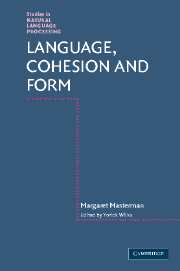Book contents
- Frontmatter
- Contents
- Preface
- Editor's introduction
- Part 1 Basic forms for language structure
- 1 Words
- 2 Fans and Heads
- 3 Classification, concept-formation and language
- Part 2 The thesaurus as a tool for machine translation
- Part 3 Experiments in machine translation
- Part 4 Phrasings, breath groups and text processing
- Part 5 Metaphor, analogy and the philosophy of science
- Bibliography of the scientific works of Margaret Masterman
- Other References
- Index
2 - Fans and Heads
Published online by Cambridge University Press: 22 September 2009
- Frontmatter
- Contents
- Preface
- Editor's introduction
- Part 1 Basic forms for language structure
- 1 Words
- 2 Fans and Heads
- 3 Classification, concept-formation and language
- Part 2 The thesaurus as a tool for machine translation
- Part 3 Experiments in machine translation
- Part 4 Phrasings, breath groups and text processing
- Part 5 Metaphor, analogy and the philosophy of science
- Bibliography of the scientific works of Margaret Masterman
- Other References
- Index
Summary
The construction of the fan
Let us take a word, its sign, and its set of uses.
Let us, in the simplest case, relate these to reality; about which we shall say no more than, since it develops in time, the uses of the word must also develop in time.
Let us denote the word by a point; its sign by an ideograph (Masterman 1954), and its set of uses – all linking on to reality at unknown but different points, but all radiating out from the original point denoting the word, because they are all the set of uses of that same word, by a set of spokes radiating from that point.
Let us call the logical unit so constructed, a FAN, and the figure will give the essential idea of such a fan (see Figure 2).
From Figure 2 several facts can be made clear. The first is that, however many uses the word may have (however many spokes the fan may have), they will always be marked with the same sign. But it does not follow from this that all the uses of the word mean the same thing; that they all have the same meaning in use.
- Type
- Chapter
- Information
- Language, Cohesion and Form , pp. 39 - 56Publisher: Cambridge University PressPrint publication year: 2005

